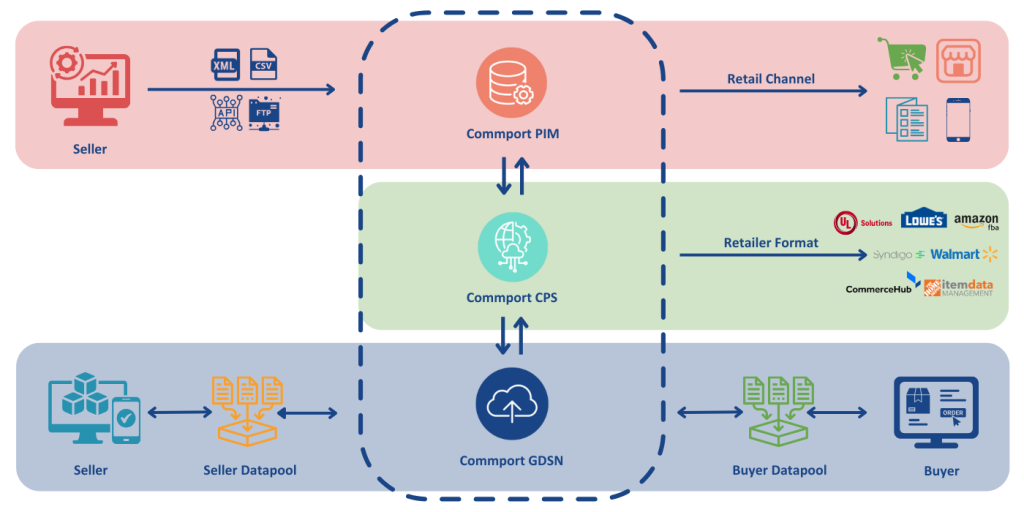Introduction
High-quality, consistent, and accurate product information is no longer optional—it’s a requirement. With buyers searching for products across multiple platforms and devices, ensuring your product content is available and optimized in every marketplace is essential. This is where product syndication becomes a game-changer.
By automating the distribution of your product data to various sales channels, Product syndication enables businesses to expand their reach, enhance customer experiences, and boost sales. In this guide, we’ll delve into the importance of product content syndication, explore its types, and discuss how to automate the process for maximum efficiency.
Key Takeaways
- Automated product syndication ensures consistent and accurate product information distribution across multiple sales channels.
- It saves time and resources by eliminating the need for manual updates and data entry.
- Automation improves product data quality, enhancing customer trust and purchase decisions.
- It ensures compliance with retailer-specific formatting and content requirements.
- Streamlined syndication processes boost efficiency, helping businesses scale their operations seamlessly.
Importance of Product Syndication
1. Ensuring Consistency Across Multiple Platforms
Consumers expect consistent product information whether they’re shopping on Amazon, Walmart, or your brand’s website. Discrepancies in product details can erode trust and lead to lost sales. Product content syndication ensures that all your sales channels display up-to-date and accurate information.
2. Expanding Market Reach
Syndicating your product content across various marketplaces and retail platforms enables you to reach a broader audience. With more than 2.5 billion online shoppers globally, businesses cannot afford to limit their presence to just one or two channels.
3. Enhancing Customer Experience
Customers who find detailed, accurate, and visually appealing product content are more likely to make informed purchase decisions. This reduces returns and improves overall satisfaction.
4. Improving Operational Efficiency
By automating syndication, businesses can save time and resources. Instead of manually uploading product data to individual platforms, automation tools streamline the process, minimizing errors and maximizing efficiency.
Different Types of Product Syndication

Product content syndication can vary based on the platforms, content formats, and the level of automation involved. Let’s break down the common types:
1. Manual Syndication
This involves manually uploading product content to each sales channel or marketplace. While cost-effective initially, this method is time-intensive and prone to human error.
2. Semi-Automated Syndication
Semi-automated syndication uses tools like spreadsheets or templates to manage and upload product data to multiple platforms. Although faster than manual syndication, it still requires significant oversight.
3. Fully Automated Syndication
Fully automated syndication uses advanced solutions like Product Information Management (PIM) systems or Global Data Synchronization Network (GDSN) platforms to distribute product content seamlessly. This method is ideal for businesses with large product catalogs and multiple sales channels.
How to Automate Product Syndication to Multiple Marketplaces

Step 1: Centralize Your Product Data
Start by consolidating all product information in a centralized database or PIM system. This includes product descriptions, images, pricing, dimensions, and specifications.
Step 2: Standardize Data Formats
Different marketplaces have unique requirements for product data. Standardize your data to ensure compatibility across platforms.
Step 3: Use Automation Tools
Implement tools like GDSN or PIM systems to automate data distribution. These tools can automatically adapt your content to meet each platform’s requirements.
Step 4: Test and Validate
Before going live, test your product content on each platform to ensure accuracy and consistency.
Step 5: Monitor and Optimize
Regularly review your product listings across all platforms to identify and address any discrepancies. Optimize your content based on performance analytics.
List of Solutions to Use to Automate Product Syndication
1. Product Information Management (PIM) Systems
PIM solutions, such as Commport PIM, allow businesses to manage and distribute product information from a centralized location.
2. Global Data Synchronization Network (GDSN)
Commport GDSN solution ensures the secure and seamless exchange of standardized product data between manufacturers and retailers.
3. E-commerce Platform Integrations
Tools like Commport PIM or GDSN can automate product content syndication across e-commerce platforms like Amazon, Shopify, and eBay.
4. Content Management Systems (CMS)
Advanced CMS platforms can simplify syndication by integrating with marketplaces and syndication networks.
5. API Integrations
Custom APIs from Commport Communications enable direct communication between your database and sales channels, ensuring real-time updates.
Benefits of Product Syndication
1. Increased Sales
Accurate and optimized product content improves search visibility and conversions, leading to higher sales.
2. Reduced Errors
Automation minimizes manual errors, ensuring accurate product listings across all platforms.
3. Time Savings
With automated syndication, businesses save valuable time that can be redirected to strategic initiatives.
4. Scalability
Syndication tools allow businesses to easily expand their product offerings across new platforms without significant overhead.
5. Better Analytics
Many syndication solutions offer performance insights, helping businesses optimize their content strategy.
Conclusion
Product content syndication is no longer just a competitive advantage—it’s a necessity for businesses looking to thrive in the digital age. By automating this process, you can ensure consistent, accurate, and engaging product information across all channels, boosting customer trust and driving sales.
Whether you’re a small business or a global enterprise, investing in the right tools and strategies for product content syndication can deliver measurable benefits.
Commport Datapool Solutions
Download: GDSN Buyers Guide
Empower your business with global data synchronization; download our GDSN Buyer's Guide today and take the first step towards streamlined, accurate, and compliant product data management.
Frequently Asked Questions
Product content syndication is the process of distributing product data, such as descriptions, images, and specifications, to multiple sales channels or marketplaces.
Tools like PIM systems, GDSN platforms, and e-commerce integrators can automate and streamline the syndication process.
Yes, automated syndication can save time and reduce errors, making it a valuable investment even for small businesses.
Manual syndication is time-consuming, prone to errors, and can lead to inconsistent product listings across platforms.
GDSN uses a standardized data format to synchronize product information between manufacturers and retailers in real time.
Automation reduces errors, saves time, improves data consistency, and allows for better scalability.
Yes, most syndication tools offer API integrations to connect with existing databases, ERP systems, or CMS platforms.
Consistent product content builds customer trust, improves search rankings, and reduces return rates.





